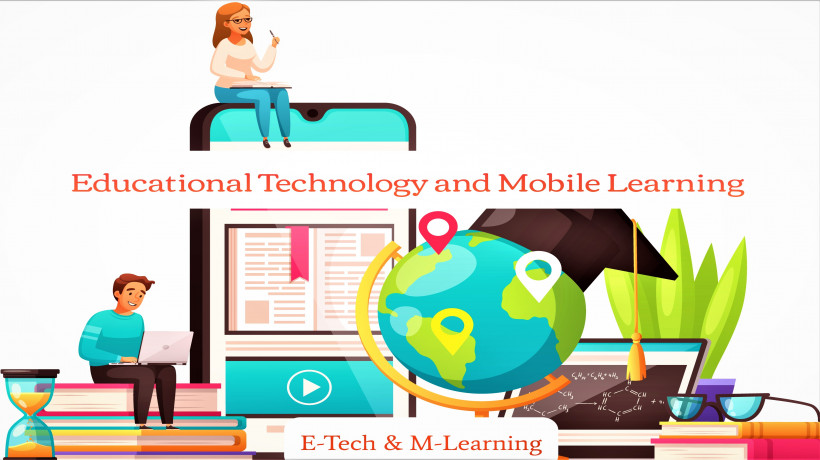Educational Technology and Mobile Learning
In new era of learning, we will experience custom learning by means of smart, sensor enabled & visual gadgets. Here’s a blog to deliver an insight on Educational Technology & Mobile learning!
December 08, 2021

Career Expert & Blogger

Educational Technology (EdTech)
Students today are constantly engaged in utilizing technology, this engagement opens up ways to remarkable opportunities for schools, teachers, and guardians. It can make both teachings and learning a great opportunity. As each student has his own ways of learning, so technology permits teachers to oblige interesting learning styles according to the situation. EdTech is rapidly replacing the part of textbook readings in the study halls and students are learning subjects with the guide of customized computer programs that help them according to their necessities.
Today, educational technology is used to meet the needs of students and adults. It can be used to address the needs of exceptional children and adults, especially those in remote locations or schools with few or no educators. It can also be used to improve the quality of education for everyone. However, the term should not be confused with the word “educational technology,” which encompasses a variety of different domains. For example, e-learning involves using online tools and services, whereas m-learning involves computer-based training.
In the field of education, EdTech can help educators to offer a broader range of courses to students. Besides classroom instruction, EdTech can be used to develop online courses for students. These online courses enable them to learn at their own pace, and at their own convenience. And because these courses are not confined to classrooms, the students can learn at any time, anywhere. In addition to online courses, these programs can be used to train new nurses and other healthcare professionals.
The scope of educational technology is broad. It includes computer-based instruction, multimedia learning, and computer-mediated communication. It also includes computer-based training, internet-based learning, and distributed learning. It encompasses the use of information and communication technologies in the field of education. And it’s not just about computer-based training. Rather, it can also include educational apps and websites, as well as flexible, distance learning, and individualized learning.
The field of education technology can involve many different tools. Those in the field of education use a variety of tools, such as computers and laptops, to teach students. In some cases, educational technology is used to improve learning. Various educational software and hardware are available to help teachers improve their teaching methods. There are many different types of EdTech. One of these is self-based. Another type is asynchronous, which is an online course that is accessible to multiple users.
Some educational technologies are used for a variety of purposes. For example, they can help students with learning disabilities understand and retain information better. In addition to providing support for students with learning disabilities, educational technology can also help schools reduce the costs of classroom supplies. By leveraging digital tools, educators can provide personalized learning experiences for their students. These tools will make the process easier and more effective for all involved. There are many benefits to the use of these technologies in education.
While educational technology has a wide range of applications, it is most commonly used in higher education. Whether it is used to teach online courses or impart correspondence education, it can benefit students and teachers alike. Often, the best way to use educational technology is to create a school environment that supports the scientific foundation of the institution. By utilizing technology in the classroom, educators can provide better experiences and outcomes for students. It is also useful to support new discoveries and developments.
The use of edtech in education has a variety of benefits for both students and educators. It can augment in-person teaching and be used to supplement it. This technology can also help students with learning disabilities. It can be applied to help those with learning disabilities learn and improve their skills. It can improve the quality of learning in a school or online. If you’re a teacher, then you may want to consider this specialty in order to maximize the use of educational technology in your classroom.
The use of educational technology is a growing part of modern society. It has the potential to improve the quality of education, and it can improve the way in which people learn. It can enhance the work of teachers and students, and it can help teachers and students alike. Increasingly, education has become a global endeavor, and there is a need for innovative ways to incorporate tech in the classroom. In this context, technological advances in the field of education can help all aspects of society.
- EdTech allows teachers to create customized lessons and increase classroom participation.
- Educational technology uses hardware, software, and other IT tools to advance learning.
- Teachers may use EdTech to automate repetitive tasks and help with grading and attendance.
Top 10 Current Educational Technology Trends In 2020/2021
If you are an innovative educator, following the trends in education is probably not something new but rather essential. Even with this list, however, it is still up to you to choose the most suitable "trendy" aid for your teaching and training. Here we select the 10 latest educational technology trends that are must-know when diving into this industry.
- eLearning: Immediately upon the rapid growth of COVID-19 and subsequent school closings, distance learning emerged as the most significant educational technology trend for 2020. As a result, demand for online learning systems increased. Electronically provided education or training is known as eLearning. A firm can use online courses to help train staff in critical skills, or slide-based online exercises.
- With eLearning, students simply sponge up knowledge through reading or viewing content, changing the way education is provided. A multimodal and useful learning experience is also created by the fact that many eLearning courses contain animation, podcasts, and videos.
- The best aspect of online learning systems is their diversity. You have the option of using recorded (asynchronous) approaches with a wealth of video and digital tools accessible to enhance courses, or you can teach your students in real time (synchronous) via live stream or group meetings using Zoom or Microsoft Teams. To measure your students' learning outcomes, a strong online learning platform can be paired with a learning management system (LMS).
- Video-Assisted Learning: The use of video-assisted learning in classroom displays has grown significantly in recent years. The "video day" is no longer a television brought into a classroom on a cart. With the internet and modern technology, "video day" may be any day.
- In distance learning settings, where students study from computer displays, this tendency is also rising.
- Ones, especially animated videos, are a great way to enhance courses and improve comprehension of the material. It raises student achievement while lightening the load on teachers.
- Blockchain Technology: Data storage is just one advantage that the Distributed Ledger Technology (DLT) from blockchain offers to education. The amount of storage is theoretically infinite since each time new data is added, it creates another "block" to the system. The data will be dispersed throughout the system's many computers while also being encrypted. Data exchange becomes decentralised and transparent as a result.
- Massive Open Online Courses (MOOCs) and ePortfolios leverage blockchain technology to validate students' skills and knowledge.
- For eLearning agencies, the DLT systems will provide solutions to the issues of authentication, scale, and affordability. Additionally, during the job-search phase, it might assist student applicants in publishing their successes.
- Artificial Intelligence (AI): In today's EdTech sector, AI is the "in" thing. According to predictions, AI will likely dominate trends through 2021 and expand by more than 45%. So why is one of the biggest EdTech marketplaces in the world experiencing a trend boom? The primary use of AI in education is to automate routine tasks like grading. The grading of multiple-choice and fill-in-the-blank questions can now be automated by teachers. As a result, computerised writing assessment of kids may not be far behind.
- STEAM: STEAM-based programs are the new EdTech improvement over the STEM programs. This new trend of EdTech applies meaningful Science, Technology, Engineering, Art (the new element), and Math content to solve real-world problems through hands-on learning activities and creative design.
- Social Media in Learning: Social media is now widely used in educational institutions as a communication tool so that students may readily communicate with one another. Shared study materials, group discussions, and simple commenting are all options available to students. Even an animated educational video has the potential to go viral online. TedEd is a prime illustration of this pattern. The educational videos produced by this group are posted on YouTube where individuals may quickly access, find, and share them with their peers.
Mobile Learning (MLearning)
MLearning can be defined as education or training conducted by means of portable computing devices, for example, cell phones or tablet computers. According to latest reports, 80% of students use cell phones during the daytime. Hence, it makes it feasible to utilize it for the learning interaction.
The main purpose of education is to enable the mind with data and Technology, and it also makes our work simpler. These remote handheld gadgets have better infiltration even in provincial zones where education requirements are not easily available.
Mobile devices have become attractive learning devices for education. While the majority of the existing research has focused primarily on the value of mobile learning for students, researchers have recently started exploring its potentials within teacher development.
The trends and gaps observed in the literature regarding the integration of mobile learning into teacher education. Six main findings emerged:
(a) there is an increasing trend in integrating mobile learning in teacher education contexts;
(b) theoretical and conceptual perspectives are scarcely reported;
(c) variations exist in perceptions, attitudes and usage patterns;
(d) engagement with mobile learning and devices is primarily reported as being beneficial;
(e) challenges were scarcely reported; and
(f) several pedagogical affordances support mobile learning integration into teacher education settings.
Ensuring Tech Infrastructure Can Support Mobile Learning
Because mobile learning isn’t fully remote and can be partly facilitated on campus, good connectivity is required both in class and outside of it.
- “Beefing up the Wi-Fi is absolutely crucial,”
- Embracing the cloud is also necessary for adequate bandwidth, security, ease of use and future-proofing.
- “You see all LMS services — Canvas, Moodle, Blackboard — moving to the cloud and being supported by big cloud services,”
- Because m-learning can employ streaming or uploaded video, such as lectures, cloud also offers instructors an easier way to bring content to students
Transforming teacher education practices with theoretically sound approaches
Teacher educators need to go beyond the tools’ potential to explore pedagogical benefits of mobile learning within their own content areas. This change will help preservice and in-service teachers realize the pedagogical advantages of mobile learning that may shift their perspectives toward the integration of mobile devices into their teaching environments.
Conclusion
The development of a nation depends on the educational framework. At this point when it is paired with interpersonal relationships, insightful teachers, and deliberate projects, it can help to reframe the current learning and teaching environment

